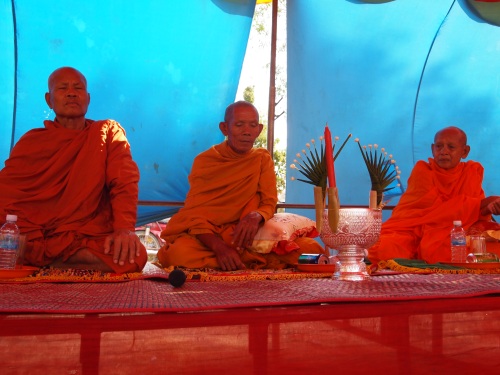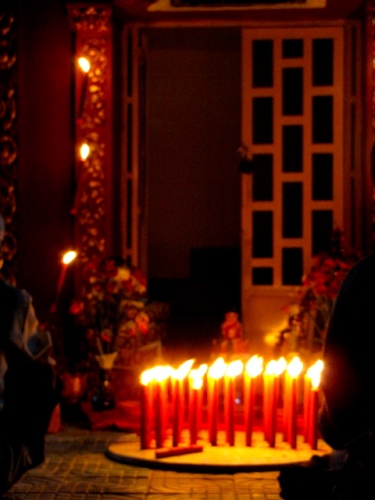
Rosy-hued plates of lotus petals, jasmine buds, and candied confections laying on the altar at the stupa ceremony – Samroung, Takeo (Photo by Katie Markovich)
This is the second article of a series I have dubbed, “Catching Up,” also known as, “An Attempt to Redeem Myself.” The series covers the period between January and March 2013 when there was a big gap called, “The Time When I Wrote Nothing.” The series continues with observations of a stupa dedication ceremony I saw on a visit to Takeo in February 2013, by invitation from Kolap Mao, the ever so helpful library director at Paññāsāstra University Library in Phnom Penh. Heaps of thanks to Katie Markovich, fellow 2012-2013 Cambodia Fulbrighter, for sharing her photos. Due to my stupidity, most of my images from the trip were taken with my camera programmed on an awful resolution setting.
Dry season in Cambodia means that colors are in – for Temporarily Erected Structures to be exact.
For example, it is nearly impossible to escape stumbling upon a wedding tent pitched outdoors, sometime between November and April, a window of time on the Cambodian calendar that is relatively free of the monsoons that are a psychotic trademark of the wet season.* These tents, which may occupy nooks in provincial villages or swallow up entire blocks of street in the city, are clothed in sheaths of glossy curtains and drapery, and accessorized with bows and garlands, donning pastels and neons of pink, orange, yellow, blue, red, and purple. There is no such thing as having too much color, and there is no such thing as utilizing too many colors at the same time. Nothing in Cambodia makes more of a visual statement under the category of “Temporarily Erected Structures” than these wedding tents, save for one exception: the tents I saw set up for the dedication of a stupa in Takeo. (A stupa is a Buddhist structure used to inter the cremated remains of the dead, and a variation of it often inspires the design of many genocide memorials in Cambodia, such as the famous stupa at Choeung Ek. A family may take a number of years to save up enough money to design and construct the stupa, which may be used for multiple family members. Before the ashes are interred though, prescribed Buddhist ritual is required to obtain permission for the remains to be housed and welcomed into the stupa.)

Tent of many colors shelters guests for the stupa dedication ceremony – Samroung, Takeo (Photo by Katie Markovich)
Funeral tents in Cambodia are typically black and white and silver, but these colors of somber mourning were not prominently featured at this ceremony in Takeo. Instead, hot pink, accompanied by accents of electric blue, solar yellow, and genetically-modified carrot orange bathed the occasion. (In my mind, this is a palette inspired by the spandex that was most likely in plentiful supply in a jazzercise aerobics class during the 80s.) Guests shuffling in and out of the tent throughout the ceremonial proceedings were each a slightly different shade of pink, courtesy of a laborious sun churning through the fabric and leaking a rosy-colored spotlight on the inhabitants beneath.

Guests at the ceremony lounge throughout the day, within view of the stupa – Samroung, Takeo (Photo by Katie Markovich)
One tent to the right of the stupa was reserved for serving meals and for general seating. This is where most of the guests congregated. The second tent to the left of the stupa was reserved primarily for the ceremony’s Buddhist ritual activity. There, a priest recited the prescribed incantations (supported by a robust loud speaker system that could be heard from the top of the local mountain, Phnom Chisor); a band of musicians demurely seated on mats played traditional Khmer instruments (supported by the same robust loud speaker system); monks from the local temple sat atop a wooden platform to oversee the activity; and a group of women from the village huddled on the ground and crafted ceremonial decorations out of jasmine buds and palm leaves.

Monks from the local temple attending the ceremony – Samroung, Takeo (Photo by Katie Markovich)

Women from the community gather to cut and fold and tie trinkets of jasmine buds and palm leaves that will lace the premises of the stupa ceremony site – Samroung, Takeo
The human activity was ceaseless, but what magnetized me most under the second tent was the still life at the altar, far from the loud speaker on the opposite end of the tend. It lay styled with a stunning array of ceremonial wares, arranged with delicate care and a calculating eye. The urn containing the ashes rested near the center and it sat wrapped as tight as a Victorian corset in palm leaf and white string. It was surrounded by plates of lotus petals, mounds of candies in shiny wrappers, standing bamboo shoots and long-stemmed pink and yellow blooms, a portrait framed in metallic pink and gold tinsel, red wax candles jammed into sandy husked coconut holders, and in the background, a diorama illustrating a narrative scene of the Buddha. This altar was flooded, with objects in a technicolor blaze.

The carefully arranged altar – Samroung, Takeo
The performance of memorialization continued for two days, with fireworks launched from the rice paddy nearby, Christmas stringed lights twinkling across the premises, and 12 candles, hissing in front of the stupa door, issuing a steady streak of vermilion red.

The evening stupa ceremony comes to a close – Samroung, Takeo
Just as the priest, with a fully functioning microphone in hand, let out the last series of shouts, into the moonless night, the ashes were laid to rest, inside the burgundy, gold-trimmed stupa. Remembering the death of this family member here was far from any blurry, passive exercise. Unlike many of the forgotten local genocide memorials, it was a community collaboration, it was bold, it was loud, it was colorful, it was anything but void of life.
*To Whom It May Concern: I believe it is rather inconsiderate to block the entire width of Street 450 with your wedding tent. The road is public space. Leave some walking space. I had to take a detour around your tent last week. And I was on foot. And it was a hot day. End of complaint.
I have noticed you don’t monetize your blog, don’t waste your traffic, you can earn extra bucks every month because
you’ve got hi quality content. If you want to know how to make extra money,
search for: best adsense alternative Boorfe’s tips